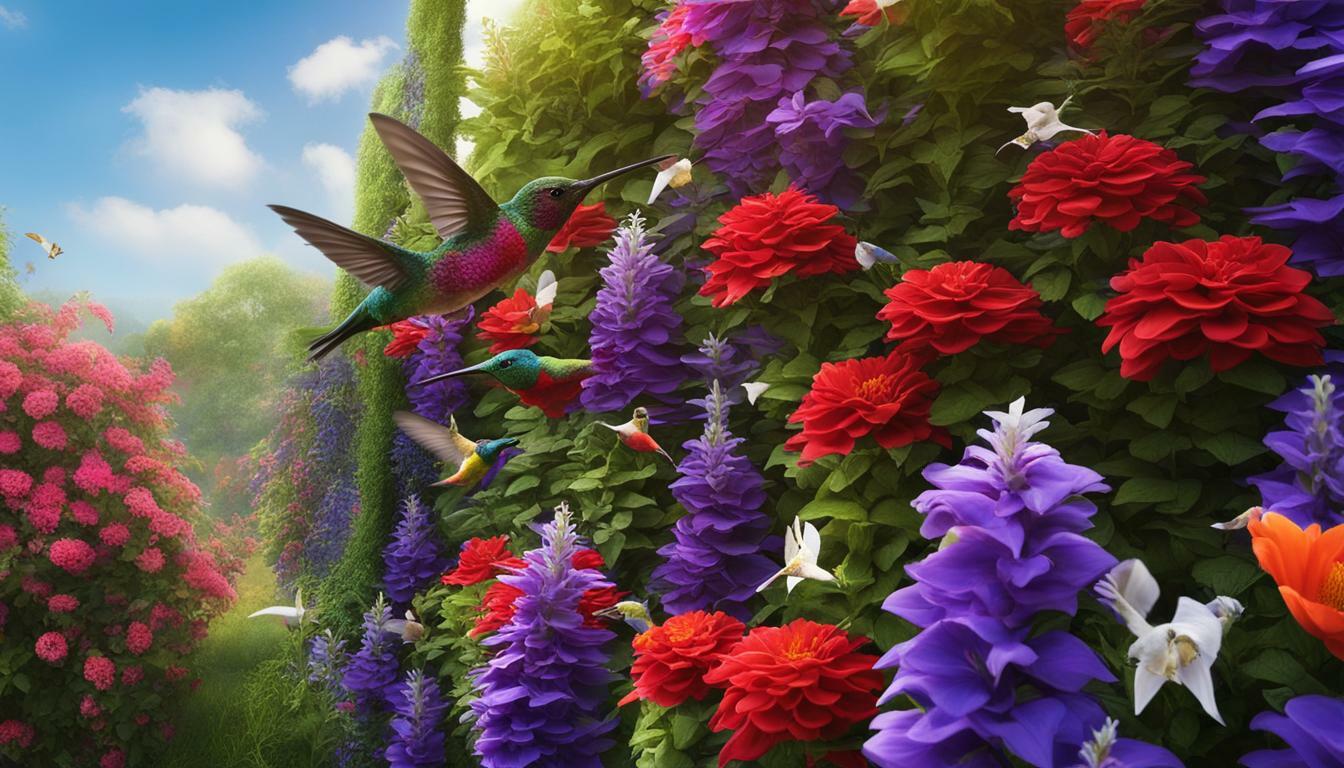Welcome to our expert guide on creating a hummingbird vertical garden in the USA. Discover how to attract these beautiful birds to your garden and create a thriving sanctuary for them.
Key Takeaways:
- Create a hummingbird-friendly garden by providing a mix of tall trees, shrubs, and meadows.
- Design your hummingbird vertical garden with vertical structures like trellises and window boxes.
- Select native plants that offer tubular-shaped flowers and provide nectar throughout the hummingbird season.
- Include water features, perching areas, and nesting materials to make your garden attractive to hummingbirds.
- Practice hummingbird-friendly gardening by avoiding insecticides and providing a year-round food source.
- Troubleshoot common issues like low hummingbird activity and maintain your garden for long-term success.
Why Hummingbirds Love Vertical Gardens
Hummingbirds are drawn to vertical gardens for a variety of reasons. In this section, we will explore why these unique garden structures are so appealing to these tiny birds and provide tips on creating a garden that is welcoming to them.
One of the main reasons hummingbirds love vertical gardens is because they often mimic the natural habitat that these birds prefer. Hummingbirds are typically found in forest and forest edge areas, where they have access to tall trees, shrubs, and patches of meadows and lawns. Vertical gardens that incorporate a mix of tall plants, such as trellises, trees, and climbing vines, can provide a similar habitat for hummingbirds to thrive in.
Vertical gardens also offer a variety of nectar-rich flowers that are perfect for hummingbirds. These birds have long beaks and tongues that are specifically adapted for feeding on the nectar found in tubular-shaped flowers. By planting native plants with tubular flowers, such as trumpet vine, coral honeysuckle, cardinal flower, and bee balm, you can create a hummingbird-friendly garden that provides them with an abundant source of food.
| Vertical Gardening Tips for Attracting Hummingbirds |
|---|
| Choose native plants with tubular flowers |
| Provide a variety of flowering plants that bloom at different times of the year |
| Add water features, such as misters or shallow baths, for hummingbirds to bathe and drink from |
| Include perching areas, such as trees or dead branches, for hummingbirds to rest and observe their surroundings |
| Avoid the use of insecticides, as hummingbirds rely on insects for protein |
In addition to nectar, hummingbirds also require a source of water for bathing and drinking. Consider adding water features, such as misters or shallow baths, to your vertical garden to attract these birds. Providing perching areas, such as trees or dead branches, is another way to create a welcoming environment for hummingbirds.
Remember to choose native plants for your vertical garden, as they not only provide a reliable source of nectar but also support the local ecosystem. By incorporating these tips into your vertical garden design, you can create a haven that will attract and sustain hummingbirds throughout the year.
Designing Your Hummingbird Vertical Garden
Designing a hummingbird vertical garden requires careful planning to create an attractive and functional space for both the birds and the gardener. Let’s explore some design ideas to get you started.
When sketching your yard to plan for your hummingbird vertical garden, consider the location of your house, outbuildings, and existing landscape features such as trees, shrubs, and flower beds. Work with these existing features and enhance them with additional plantings. Choose a focal point for your garden, such as a flower box, trellis, or hanging garden, and place it in a spot where you can easily observe the hummingbirds’ activity from a window or patio door.
for your hummingbird vertical garden, consider the location of your house, outbuildings, and existing landscape features such as trees, shrubs, and flower beds. Work with these existing features and enhance them with additional plantings. Choose a focal point for your garden, such as a flower box, trellis, or hanging garden, and place it in a spot where you can easily observe the hummingbirds’ activity from a window or patio door.
To maximize vertical space in your garden, think creatively about how to incorporate structures like trellises, trees, sheds, or even window boxes and pots. These structures can provide support for climbing vines and create a terraced effect, allowing you to grow a variety of plants that will attract hummingbirds. Consider using native plants that hummingbirds feed on in natural areas near your home, as they have a long association with local hummingbird species and serve as reliable sources of nectar. Red, tubular flowers are quick clues to a flower’s value as a hummingbird food supply, so choose plants with these types of blooms. Selecting plants that bloom at different times of the year will ensure a continuous supply of nectar for hummingbirds throughout the season.
When designing your hummingbird vertical garden, it’s important to provide not only food sources but also nesting and perching areas for the birds. Include fuzzy plants like cinnamon fern and pussy willow, which hummingbirds use to line their nests. Create water features, such as shallow baths or misters, for the hummingbirds to drink from and bathe in. Additionally, incorporate perches within 10 to 20 feet of the garden, using dead branches with small twigs or live trees if space permits. These perches serve as resting spots for the birds and can also be used as springboards for their courtship displays.
To supplement the text, here is a table summarizing the design elements for a hummingbird vertical garden:
| Design Elements | Function |
|---|---|
| Sketch your yard | Plan the layout of your garden and identify existing features |
| Choose a focal point | Create a central area to attract hummingbirds |
| Think vertically | Utilize structures like trellises, trees, and pots to maximize vertical space |
| Select native plants | Choose plants that hummingbirds feed on in natural areas near your home |
| Choose red, tubular flowers | Opt for flowers that are attractive to hummingbirds |
| Plant in patches | Create larger quantities of nectar by grouping plants of the same species |
| Plan for year-round bloom | Select plants that bloom at different times of the year to provide a continuous nectar source |
| Provide nesting and perching areas | Incorporate fuzzy plants and create perches within proximity to the garden |
| Create water features | Add shallow baths or misters for hummingbirds to drink from and bathe in |
| Ensure easy maintenance | Prune plants to prevent excessive growth and favor flower production |
By following these design tips, you can create a hummingbird vertical garden that not only attracts these delightful birds but also enhances the beauty of your outdoor space. Enjoy the sights and sounds of hummingbirds as they visit your carefully crafted garden oasis.
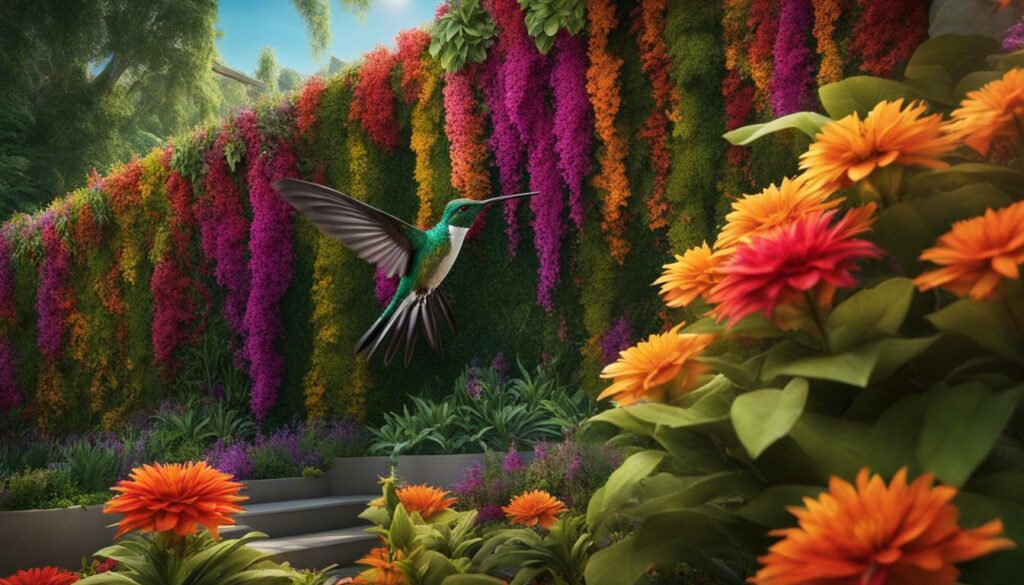
Choosing Plants for Your Hummingbird Vertical Garden
The key to a successful hummingbird vertical garden lies in selecting the right plants that will provide the necessary nectar and habitat for these tiny birds. Let’s explore some plant options that are sure to attract and delight hummingbirds.
Native plants are the best choice for a hummingbird vertical garden as they have a long association with local hummingbird species and provide a reliable source of nectar at specific times each year. When selecting plants, focus on native species that are known to attract hummingbirds in your area. Avoid exotic flowering plants, as they may look promising but lack the necessary nectar production.
Choose plants with red, tubular flowers, as these are quick clues to a flower’s value as a hummingbird food supply. Hummingbirds are also attracted to orange and pink flowers, but they find yellow and white blooms less appealing. Select plants that bloom at different times of the year to provide a consistent nectar source throughout the hummingbird season.
Planting patches of the same species (three or more plants) will provide larger quantities of nectar and make your garden more attractive to hummingbirds. Pruning your plants to prevent excessive woody growth and favoring flower production is also important. Remember to create a mix of plants with varying heights and structures to offer different perching and feeding opportunities for hummingbirds.
| Plant | Flower Color | Blooming Season |
|---|---|---|
| Nasturtium Jewel Mix | Red, Orange, Yellow | Summer |
| Dwarf Sweet Pea | Pink, Purple | Spring |
| Morning Glory Purple | Purple | Summer |
| Morning Glory Scarlet | Red | Summer |
| Marigold Sparky | Orange | Summer |
| Coleus Rainbow Mix | Various Colors | Summer |
To attract a variety of hummingbirds, it’s important to have a diverse range of plants in your vertical garden. Incorporate native plants that offer different colors, shapes, and bloom times to provide a continuous food source.
Remember, planting native milkweed not only attracts butterflies but also provides nesting material for hummingbirds. Spider webs are critical to nest construction for hummingbirds, so avoid spraying any pesticides that could harm these essential components of their habitat.
Expert Tip:
“When planning your hummingbird vertical garden, think vertically! Utilize trellises, trees, and structures to support climbing vines, and consider adding window boxes, wooden tubs, or ceramic pots to create a terraced effect. This will provide growing places for a variety of plants and offer hummingbirds more options for feeding and perching.” – Director of Citizen Science, Kathy Dale
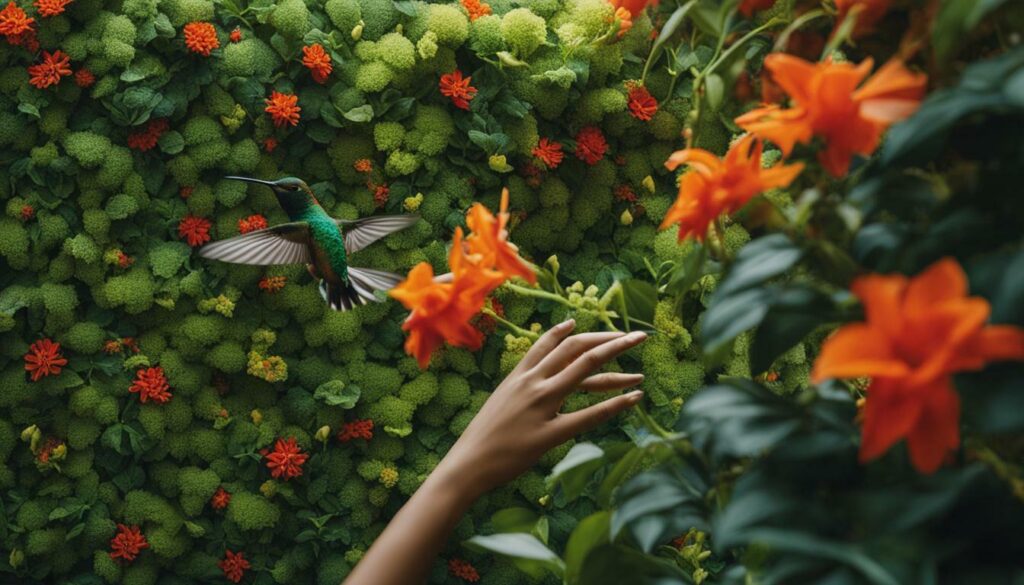
By carefully selecting the right plants and creating a diverse and vertically-oriented garden, you can create a haven for hummingbirds in your vertical garden. Enjoy the vibrant colors, delicate beauty, and joyful flights of these fascinating birds as they visit your garden throughout the year.
Care and Maintenance of Your Hummingbird Vertical Garden
Creating a hummingbird vertical garden is just the first step in providing a welcoming habitat for these beautiful birds. In this section, we will discuss the care and maintenance tasks that will keep your garden thriving.
One of the most important aspects of caring for your hummingbird vertical garden is selecting the right plants. Native species that produce tubular-shaped flowers, such as trumpet vine, coral honeysuckle, cardinal flower, and bee balm, are ideal choices. These plants provide a reliable source of nectar for hummingbirds and attract the insects they feed on. It’s also important to plant in masses and choose varieties that bloom at different times throughout the hummingbird season, ensuring a continuous supply of nectar.
Regular pruning is essential to prevent excessive woody growth and promote flower production. By removing dead or overgrown branches, you can create a more aesthetically pleasing garden and provide better access to the nectar-filled flowers. Additionally, pruning allows for better airflow and reduces the risk of disease and pest infestations.
Water is another crucial element in maintaining a hummingbird vertical garden. Hummingbirds not only need nectar but also require water for drinking and bathing. Consider adding a water feature, such as a birdbath or misters, to your garden. These will not only attract hummingbirds but also provide them with a refreshing source of hydration and a place to cool off during hot summer days.
“Hummingbirds can ingest poisons when they eat insects; systemic herbicides can also be found in flower nectar.”
Lastly, it’s important to practice hummingbird-friendly gardening practices. Avoid using insecticides in your garden, as they can be harmful to hummingbirds. Instead, encourage natural pest control by attracting beneficial insects that will help keep pest populations in check. Additionally, provide suitable nesting materials, such as downy plant fibers, moss, and lichens, for hummingbirds to construct their nests.
By following these care and maintenance tips, you can create a thriving habitat for hummingbirds in your vertical garden. Not only will you enjoy the beauty and grace of these incredible birds, but you will also contribute to their conservation and create a wildlife-friendly environment in your own backyard.
Table: Native Plants for Your Hummingbird Vertical Garden
| Plant | Description |
|---|---|
| Trumpet Vine | Produces vibrant orange-red flowers and attracts hummingbirds with its long, tubular blooms. |
| Coral Honeysuckle | Features clusters of coral-red tubular flowers that lure hummingbirds with their abundant nectar. |
| Cardinal Flower | Boasts tall spikes of vivid red flowers that are highly attractive to hummingbirds. |
| Bee Balm | Showcases vibrant flower heads in various colors, including red, pink, and purple, that hummingbirds find irresistible. |
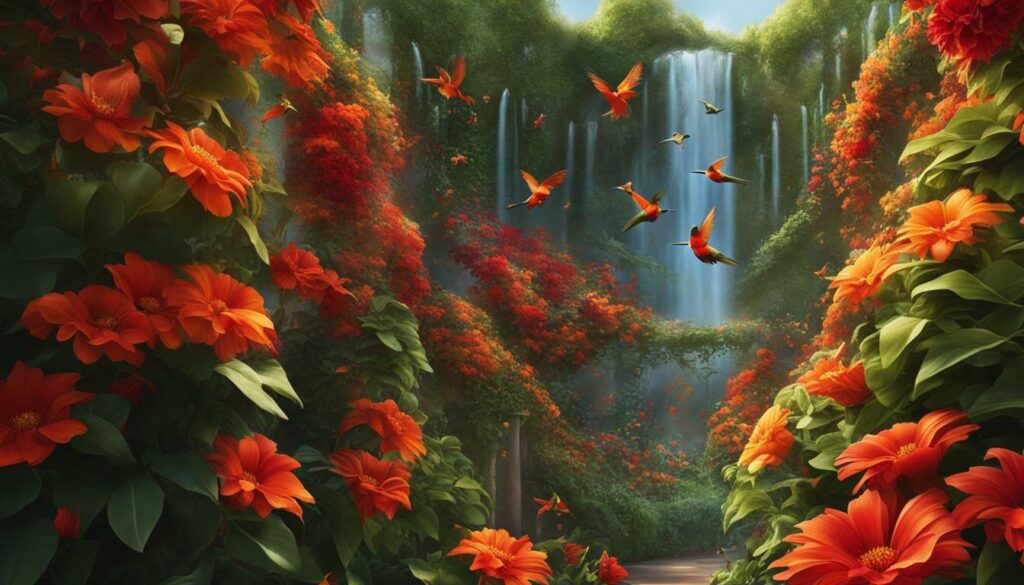
Incorporating these native plants into your hummingbird vertical garden will provide a reliable source of nectar to attract and sustain these magnificent birds throughout their migration and nesting seasons.
Water Feature in Your Hummingbird Vertical Garden
Water is an essential element for attracting and sustaining hummingbirds in your vertical garden. These tiny, energetic birds need a reliable source of water for drinking and bathing. In this section, we will discuss the benefits of including a water feature in your hummingbird vertical garden and provide tips on how to incorporate it into your garden design.
Adding a water feature to your hummingbird vertical garden not only provides a necessary resource for the birds but also enhances the overall aesthetics of your garden. Hummingbirds are attracted to the sound and movement of water, and a water feature can create a serene and inviting environment for these beautiful creatures.
One option for incorporating a water feature in your hummingbird vertical garden is to install a small birdbath or shallow water basin. Ensure that the basin has a textured surface to prevent the birds from slipping and provide a gradual slope for easy access. It’s important to keep the water fresh and clean, changing it regularly to prevent the growth of algae and bacteria.
Another alternative is to include a small waterfall or fountain in your garden design. The sound of flowing water is particularly attractive to hummingbirds and can help mask other noise in the area. Consider using recycled materials such as old ceramic pots or repurposed containers to create a unique and eco-friendly water feature.
Table 1: Recommended Water Features for Hummingbird Vertical Gardens
| Water Feature | Benefits |
|---|---|
| Birdbath | Provides a shallow and safe water source for hummingbirds to drink and bathe. |
| Waterfall | Creates a soothing and attractive focal point in your garden while providing a continuous flow of fresh water. |
| Fountain | Offers a visually appealing water feature that can be customized to fit your garden design. |
Remember to place your water feature near the hummingbird-attracting plants in your vertical garden to create a natural and convenient feeding and drinking area for the birds. Regularly clean and maintain the water feature to ensure it remains a safe and inviting space for hummingbirds to enjoy.
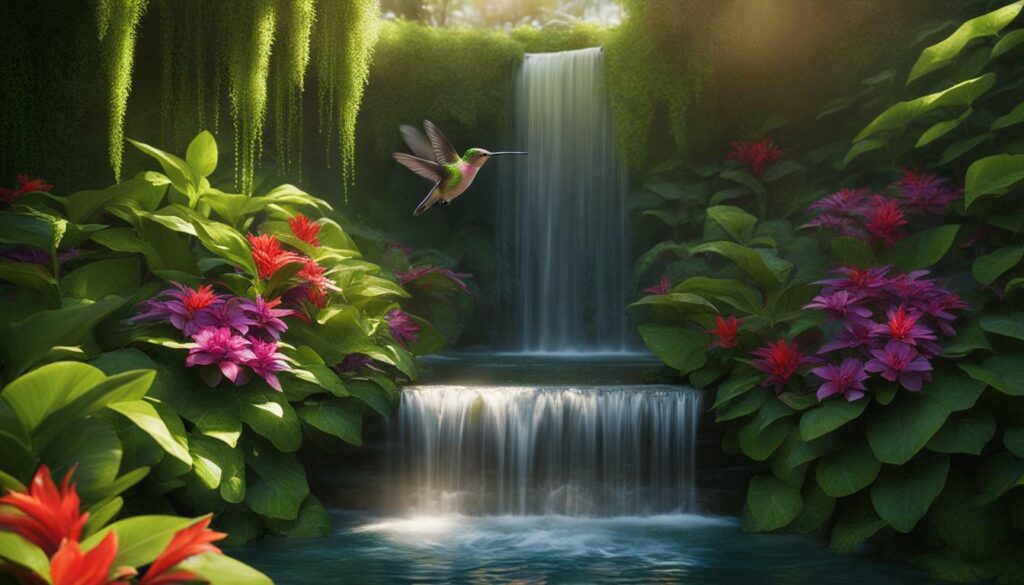
Incorporating a water feature in your hummingbird vertical garden not only provides a vital resource for these beautiful birds but also adds a refreshing and captivating element to your outdoor space. By following these tips and including a water feature in your garden design, you can create an enticing haven for hummingbirds and enjoy the beauty and activity they bring to your yard.
Providing Nesting and Perching Areas
Hummingbirds not only need nectar-rich flowers but also nesting and perching areas to feel at home in your vertical garden. In this section, we will discuss how to create these essential elements for the birds.
When it comes to nesting, hummingbirds prefer trees with hanging branches instead of horizontal ones. Maple, cottonwood, and elm trees are excellent choices for providing nesting sites. These trees not only offer secure and stable perches for hummingbirds but also provide a source of lichens—a camouflaging decoration that some species attach to the outsides of their nests with spider silk. If space is limited in your garden, consider planting smaller trees like birch or willow, which can still serve as food sources and offer nesting opportunities.
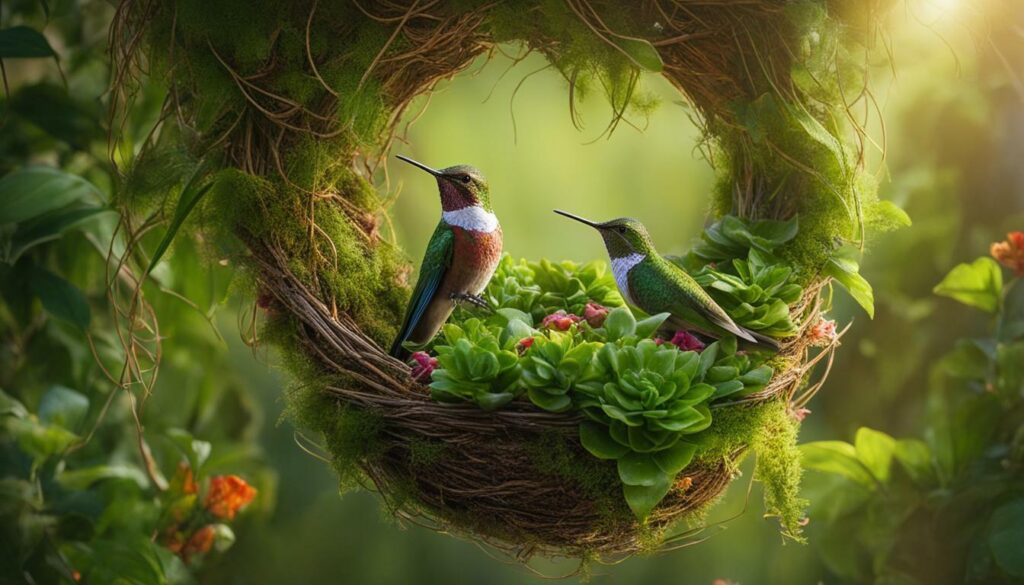
Creating perching areas is another way to attract hummingbirds to your vertical garden. Hummingbirds need perches within 10 to 20 feet of their feeding and nesting areas. While large trees are often used as perches for hummingbirds, you can also use dead branches with small twigs or install perching structures like trellises or garden stakes. These perching areas will provide resting spots for hummingbirds to observe their surroundings and conserve energy between feeding sessions.
| Plants for Nesting Material | Perching Structures |
|---|---|
| Osmunda cinnamomea (Cinnamon fern) | Trellises |
| Salix discolor (pussy willow) | Garden stakes |
| Moss and lichens | Dead branches with small twigs |
It’s important to note that hummingbirds use spider webs for nest construction, so it’s crucial to avoid using pesticides that could eliminate this valuable material. Additionally, having soft plant fibers like moss and lichens available in your garden can provide nesting materials for hummingbirds.
Quote:
“Hummingbirds may appear minutes after you set out inviting plants, but sometimes it takes several weeks before they chance on your garden. Even with luscious red flowers as bait, pure chance may keep your feeder a secret until the first migrant discovers it.” – Stephen W. Kress
By incorporating nesting and perching areas into your hummingbird vertical garden, you are providing the birds with a safe and inviting space to call home. These elements not only enhance the natural habitat for hummingbirds but also allow you to observe and appreciate these beautiful creatures up close.
Tips for Attracting Hummingbirds Year-Round
Attracting hummingbirds to your vertical garden is not limited to a specific season. With some planning and consideration, you can create a garden that attracts these fascinating birds year-round. Let’s explore how.
1. Provide a variety of native plants: Hummingbirds are attracted to native plants with tubular-shaped flowers, such as trumpet vine, coral honeysuckle, cardinal flower, and bee balm. Choose plants that bloom at different times of the year to ensure a constant supply of nectar.
2. Create vertical elements: Hummingbirds love vertical gardens, so incorporate trellises, trees, or other structures to provide climbing vines and create a terraced effect for a variety of plants. This will not only attract hummingbirds but also add visual interest to your garden.
3. Offer a water feature: Hummingbirds need water for drinking and bathing. Install a water mister, garden sprinkler, or small water fountain in your vertical garden to provide a source of water for these birds. This will not only attract hummingbirds but also add a beautiful element to your garden.
4. Include perching and nesting areas: Hummingbirds need perches for resting and nesting areas for raising their young. Add dead branches or small twigs as perches within 10 to 20 feet of your garden. Plant large trees or smaller trees that can serve as nesting sites and provide food sources.
Here is an example of a table summarizing the tips:
| Tips for Attracting Hummingbirds Year-Round |
|---|
| Provide a variety of native plants |
| Create vertical elements |
| Offer a water feature |
| Include perching and nesting areas |
Remember, attracting hummingbirds to your vertical garden requires patience and persistence. It may take some time for the birds to discover your garden, but once they do, they are likely to return throughout the seasons. By following these tips, you can create a hummingbird haven that provides food, water, and shelter, ensuring their presence in your garden year-round.
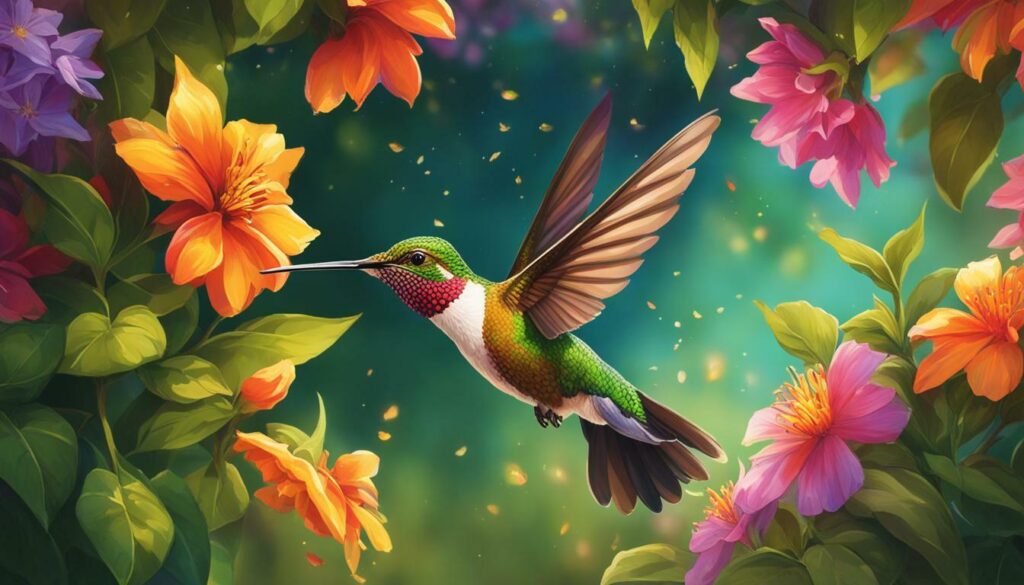
Additional Resources:
- 1. “Hummingbird Gardens” by Stephen W. Kress – A comprehensive guide to creating a hummingbird-friendly garden.
- 2. “Creating a Wildlife Habitat Garden” by Wild Birds Unlimited – Tips and advice for attracting hummingbirds and orioles to your garden.
- 3. “Garden for Wildlife” by the National Wildlife Federation – Information on creating a certified wildlife habitat that attracts hummingbirds and other wildlife.
“Attracting hummingbirds to your vertical garden is a rewarding experience that brings beauty and excitement to your outdoor space. With the right plants, design elements, and care, you can create a garden that is both aesthetically pleasing and beneficial to these amazing birds.” – Kathy Dale, Director of Citizen Science
Hummingbird-Friendly Practices
In addition to creating a hummingbird-friendly vertical garden, there are other practices you can incorporate to further enhance their experience in your garden. Let’s explore some hummingbird-friendly practices:
- Select Native Plants: Hummingbirds are naturally attracted to native plants that provide a reliable source of nectar at the same time each year. Choose red, tubular flowers as they are quick clues to a flower’s value as a hummingbird food supply. Additionally, consider planting patches of the same species to provide larger quantities of nectar and select plants that bloom at different times of the year to ensure a continuous nectar supply.
- Provide Water Sources: Hummingbirds not only need nectar but also require water for drinking and bathing. You can incorporate water baths, like garden misters, drip fountains, or small waterfalls, to provide water for hummingbirds. These water features will not only attract hummingbirds but also create an enjoyable space for them to cool off and refresh themselves.
- Create Nesting and Perching Areas: Hummingbirds require suitable nesting and perching areas in your garden. Large trees with hanging branches are ideal for hummingbird perches, as they provide a source of lichens for nest decoration. Planting trees like maples or oaks will not only offer perching opportunities but also serve as food sources and nesting sites for hummingbirds.
- Avoid Insecticides: Hummingbirds rely on insects as a protein source. Using insecticides in your garden can harm insects and impact the hummingbirds’ food supply. Opt for natural pest control methods or plant native plants that attract insects, ensuring a balanced ecosystem for hummingbirds to thrive.
By incorporating these hummingbird-friendly practices, you can create an inviting and sustainable habitat for hummingbirds in your vertical garden. Not only will you attract these beautiful creatures, but you will also contribute to their well-being and conservation.
Hummingbird-Friendly Plants
| Plant Name | Blooming Season | Preferred Habitat |
|---|---|---|
| Trumpet Vine | Summer-Fall | Suburban and rural gardens with tall trees and shrubs |
| Coral Honeysuckle | Spring-Summer | Gardens with trellises or structures for climbing vines |
| Cardinal Flower | Summer-Fall | Gardens with a mix of tall trees, shrubs, and meadow areas |
| Bee Balm | Summer | Gardens with a mix of tall trees, shrubs, and meadow areas |
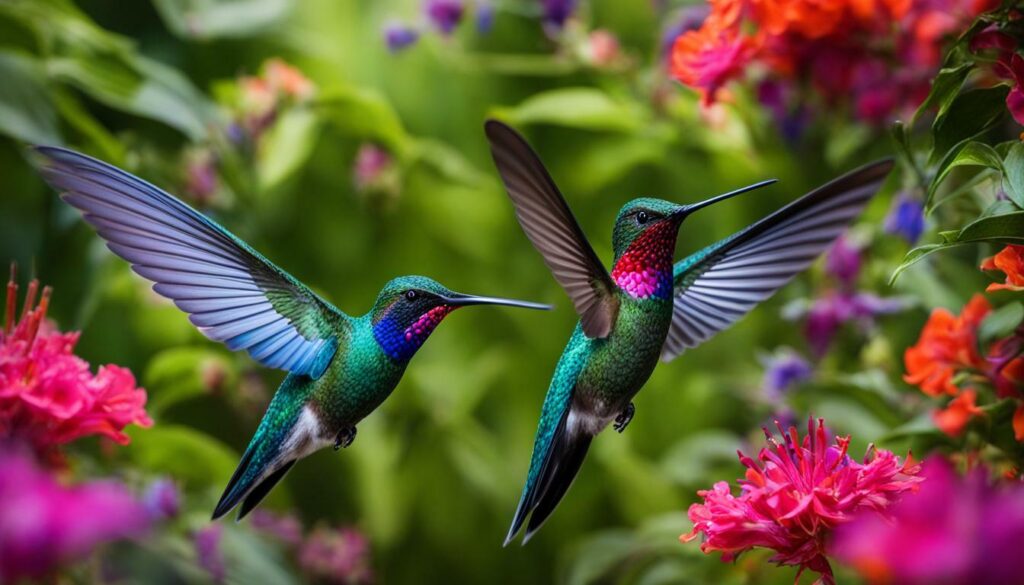
These plants provide a reliable source of nectar for hummingbirds and are well-suited for vertical gardens. Incorporating them into your garden design will not only attract hummingbirds but also create a visually stunning and vibrant space.
Troubleshooting Common Issues
Building and maintaining a hummingbird vertical garden can sometimes present challenges, but with a little know-how, you can overcome common issues and create a thriving sanctuary for these delightful birds. Here are some common problems you may encounter and how to address them:
Pest Control
One of the main challenges in maintaining a hummingbird vertical garden is dealing with pests. Insects, such as aphids and ants, are attracted to the nectar and can disrupt the hummingbirds’ feeding. To combat this, you can:
- Use natural pest control methods, such as introducing beneficial insects like ladybugs or setting up insect traps.
- Regularly check your plants for signs of pest infestation and take immediate action to remove or treat affected areas.
- Keep the area around your garden clean and free of debris to discourage pests from nesting or hiding.
Feeder Maintenance
If you’re using nectar feeders to supplement the natural food sources in your hummingbird vertical garden, it’s important to maintain them properly. Here are some tips:
- Clean the feeders regularly to prevent the growth of mold and bacteria. Use warm water and a mild detergent, or a vinegar solution, to thoroughly clean all parts of the feeder.
- Replace the nectar solution every few days, especially in hot weather, to ensure it remains fresh and safe for the hummingbirds.
- Position the feeders away from direct sunlight to prevent the nectar from spoiling quickly.
Plant Selection
Choosing the right plants for your hummingbird vertical garden is crucial to attract and sustain hummingbirds. If you’re having trouble selecting suitable species, consider the following:
“Native plants are the best offering as they produce more nectar than other plants and they also attract the insects that hummingbirds will eat, with insects being the other major part of their diet.” – Wild Birds Unlimited
Consult local gardening resources or experts to identify native plants that are known to attract hummingbirds in your area. Focus on selecting tubular-shaped flowers in red, orange, and pink hues, as these are most appealing to hummingbirds.
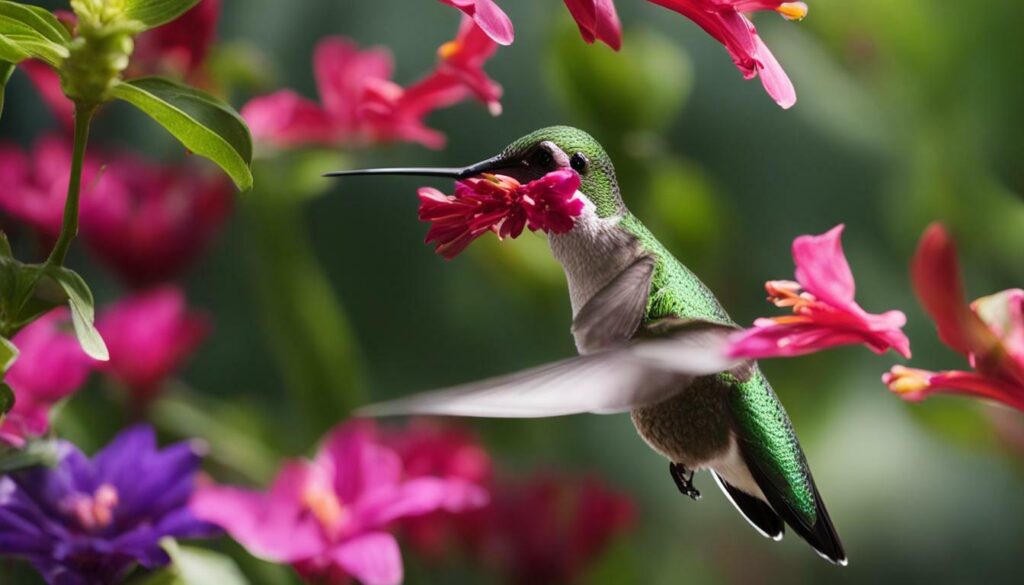
By following these troubleshooting tips and implementing effective strategies, you can overcome common issues and create a harmonious and inviting environment for hummingbirds in your vertical garden. Remember to monitor your garden regularly, make any necessary adjustments, and enjoy the rewarding experience of observing these beautiful creatures up close.
| Problem | Solution |
|---|---|
| Pest Control | Use natural pest control methods, regularly check for infestations, and keep the area clean. |
| Feeder Maintenance | Clean feeders regularly, replace nectar solution frequently, and position feeders away from direct sunlight. |
| Plant Selection | Choose native plants with tubular-shaped flowers in red, orange, and pink hues. |
By addressing these common issues and implementing the suggested solutions, you can create an inviting habitat that will attract and sustain hummingbirds in your vertical garden. With a little care and attention, you’ll be rewarded with the joy of observing these fascinating birds up close.
Conclusion
Congratulations! You now have all the knowledge and inspiration you need to create a beautiful and thriving hummingbird vertical garden in the USA. By following the expert guide and incorporating the tips provided, you can attract these fascinating birds to your outdoor space and enjoy the beauty and joy they bring.
Creating a hummingbird vertical garden is not only visually appealing but also beneficial for the birds themselves. Hummingbirds are drawn to vertical gardens due to the abundance of food, water, nesting sites, and perches they offer. By designing your garden with native plants that provide nectar and attract insects, you can create a habitat that supports hummingbird populations.
When designing your hummingbird vertical garden, think vertically. Utilize different structures like trellises, trees, and garden sheds to create a multi-dimensional and visually stunning garden. Choose native plants that have tubular or red-colored flowers, as these are particularly attractive to hummingbirds. Plant a variety of species that bloom at different times of the year to provide a continuous source of nectar.
In addition to the right plant selection, consider incorporating a water feature in your hummingbird vertical garden. Hummingbirds are attracted to shallow water sources for bathing and drinking. A water feature like a birdbath or misters can provide these essential resources and enhance the overall appeal of your garden.
To further enhance your hummingbird vertical garden, provide nesting and perching areas. Hummingbirds need suitable spots to build their nests and rest. Include structures like dead branches or live perches within the garden to create these essential spaces. Ensure that your garden remains free from harmful insecticides and offer nesting materials like soft plant fibers to attract hummingbirds and support their breeding activities.
To attract hummingbirds year-round, consider their migration patterns and create a reliable food source. Planting native species that bloom during different seasons will help sustain these birds throughout the year. Additionally, practicing hummingbird-friendly habits like regular garden maintenance and avoiding the use of chemicals will make your garden even more inviting.
In case you encounter any issues while creating and maintaining your hummingbird vertical garden, refer to the troubleshooting section for valuable tips and solutions. It’s normal to face challenges, but with the right knowledge and guidance, you can overcome them and continue to enjoy the presence of hummingbirds in your garden.
So, don’t wait any longer. Start your hummingbird vertical garden today and witness the beauty and wonder of these unique birds up close. Create a welcoming habitat for them to thrive and enjoy the rewards of their presence in your outdoor space. Happy gardening!
What are the benefits of a vertical garden for hummingbirds?
A vertical garden is ideal for beginners living wall maintenance, offering a low-maintenance way to attract hummingbirds. These gardens provide a natural habitat for the birds and offer nectar-rich flowers for them to feed on. Plus, vertical gardens save space and are an attractive addition to any outdoor space.
FAQ
Q: Why are hummingbirds attracted to vertical gardens?
A: Hummingbirds are attracted to vertical gardens because they provide a mix of tall trees, shrubs, and patches of meadow and lawn, which mimic their preferred habitat in the forest and forest edge. Vertical gardens also offer a variety of native plants with tubular-shaped flowers, which are a source of nectar for hummingbirds.
Q: How can I design a hummingbird-friendly vertical garden?
A: To design a hummingbird-friendly vertical garden, think vertically and use structures like trellises, trees, and garden sheds to support climbing vines and create a terraced effect. Select native plants with red, tubular flowers, as these are quick clues to a flower’s value as a hummingbird food supply. Plant patches of the same species to provide larger quantities of nectar and choose plants that bloom at different times of the year to provide a continuous food source for hummingbirds.
Q: What are the best plants to include in a hummingbird vertical garden?
A: The best plants to include in a hummingbird vertical garden are native plants that hummingbirds feed on in natural areas near your home. These include trumpet vine, coral honeysuckle, cardinal flower, bee balm, penstemons, salvias, fuchsias, snapdragons, monkey flowers, and western columbines. Native milkweed is also beneficial for attracting butterflies, which in turn attract orioles to their flowering stems.
Q: How do I care for and maintain my hummingbird vertical garden?
A: Regular cleaning of hummingbird feeders is essential to maintain a safe feeding station for hummingbirds. Use hot water, white vinegar, a scrub brush, and a nectar port brush to clean the feeders inside and out. Depending on the weather, change and clean the feeder every 2 days or so in warmer climates. Additionally, prune your plants to prevent excessive woody growth and favor production of flowers.
Q: Should I include a water feature in my hummingbird vertical garden?
A: Yes, including a water feature, such as a mister, garden misters, drip fountain devices, or small waterfalls, is important for providing water and a bath for hummingbirds. Like most birds, hummingbirds frequently bathe in shallow water, and having a water feature in your vertical garden can attract and provide a water source for them.
Q: How can I attract hummingbirds year-round?
A: To attract hummingbirds year-round, choose plants that bloom at different times of the year to provide a continuous nectar source. Learn about local hummingbird habits and which species are likely to occur near your home, and select plants that will bloom during the time that hummingbirds are likely to visit your yard. Additionally, provide a year-round food source, such as a hummingbird feeder, and be persistent in your efforts to attract hummingbirds, as they may take time to discover your garden.
Q: What additional practices can make my garden more inviting to hummingbirds?
A: To make your garden more inviting to hummingbirds, avoid the use of insecticides, as hummingbirds can ingest poisons when they eat insects. Provide suitable nesting materials, such as plant fibers from cinnamon fern and pussy willow, as well as moss and lichens. Plant native shrubs from the Rhamnus, Rhus, and Ribes genera, as they attract hummingbirds with their flowers and berries. Avoid spraying pesticides to preserve spider webs, which are critical for nest construction.
Q: What are some common issues I may encounter when creating a hummingbird vertical garden?
A: Common issues when creating a hummingbird vertical garden can include a lack of hummingbird activity initially, as it may take time for them to discover your garden. Visits may also drop off temporarily if there is an attractive nearby flower patch. It’s important to be persistent and continue providing a suitable habitat. Additionally, be mindful of keeping feeders clean to prevent mold and bacteria growth.
Q: How can I start creating my own hummingbird vertical garden?
A: To start creating your own hummingbird vertical garden, follow the steps outlined in this article, including drawing a sketch of your yard, selecting a good spot, choosing native plants, providing water baths, and creating nesting and perching areas. Remember to be patient and persistent, as attracting hummingbirds to your garden may take time. Enjoy the process and the rewarding experience of observing these remarkable creatures in your own backyard.

